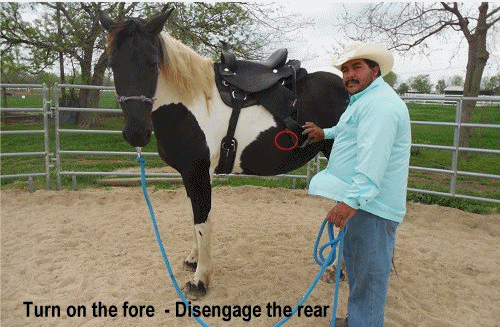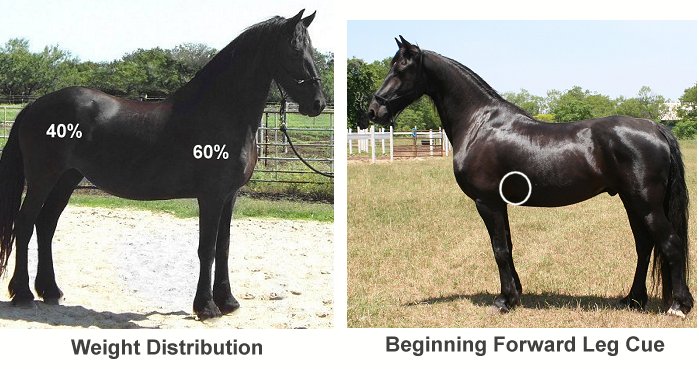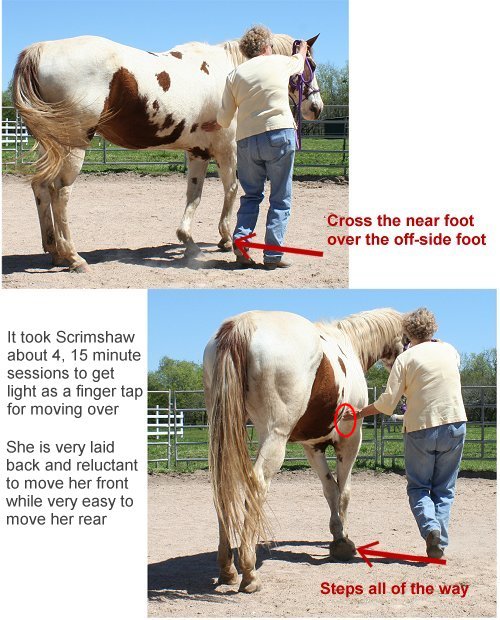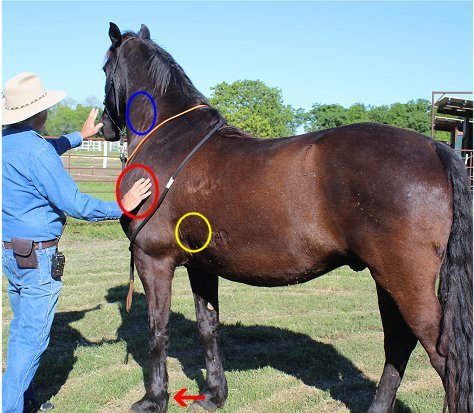A Push Button Horse: Beginning Front Leg Cue
Recap of General Leg Cues
Start on the ground. “The shortest distance between two points is through the ground.”
If you want a push-button horse, you must install the buttons. That is best done from the ground. Well-trained horses use leg cues, face cues, and seat cues to understand what their rider wants them to do. A really well-trained horse and rider can perform with leg and seat cues alone. That is the fancy “bridleless” horse you see at exhibitions.
Leg cues are used to tell the horse which part of his body to move which direction. Leg yields are used specifically to move him laterally. Simply put, your horse will feel your leg or heel pressure on a certain spot on his body, and move away from the pressure (Yield) with that part of his body. The object is to have your horse move his body off of a leg pressure so slight that a bystander cannot even tell that you have moved your leg or requested any action from your horse. It is difficult for both the horse and rider at first. But, after practice, both of you will become fluid and much more relaxed. (Also see Contact)
Your horse learned during his early ground training that moving away from pressure will end the pressure. This is central to his understanding that under saddle he should do the same: move away from the pressure.
Two legs pressuring his girth in a “neutral” position (neither forward nor behind the girth) moves him straight ahead.
Right leg pressuring his girth (slightly forward of the cinch) will move his shoulder away to the left.
Right leg pressure behind the middle (just behind the cinch) should move his hind quarters away to the left.
Right leg pressure middle should help him move his rib cage away or up so that he moves his whole body left (pictured).
Find the Button Locations
 Start in the round pen with a haltered and saddled horse. Standing facing his side with your lead rope bending his head slightly toward you, pick up the stirrup and see where the stirrup contacts the horse in a natural “neutral” position. Now pull the stirrup forward about 6″ in front of the cinch and touch his side. Then push the stirrup back 10″ behind the cinch and note that spot. These areas are a little exaggerated at first so that he will get a clear picture of which parts of his body to move with which point. As you perfect the yields, the areas will move a little closer together and he will discern with more precision.
Start in the round pen with a haltered and saddled horse. Standing facing his side with your lead rope bending his head slightly toward you, pick up the stirrup and see where the stirrup contacts the horse in a natural “neutral” position. Now pull the stirrup forward about 6″ in front of the cinch and touch his side. Then push the stirrup back 10″ behind the cinch and note that spot. These areas are a little exaggerated at first so that he will get a clear picture of which parts of his body to move with which point. As you perfect the yields, the areas will move a little closer together and he will discern with more precision.
It is the first stage of all precision riding. For weekend trail riders, it is important to be able to maneuver your horse away from trees on the trail, toward gates for opening, turning around in tight or dangerous places. An additional benefit: any horse being asked to “dance” by moving this way and that quickly and smoothly will also automatically collect and balance better. He will look more attractive, his physique and muscles in his back will improve, his attitude will be more engaged, and his ride will be smoother.
See Pressure Points of a Horse
This lesson uses several of the theories explained in other parts of this manual: Yielding to pressure, Release-Reward, Pairing Responses, and Fine-Tuning Responses. It also builds on Flex Training
I recently had the unpleasant experience of watching a horse being forced into fast turns with face and bit pressures only. The unfortunate green horse was having his face hauled to and fro and ended up with a very sore mouth while being “taught” to “follow” his face. He didn’t know what was being asked, and he fought the face pressure in a panicky attempt to get away from it. Had the horse (and/or rider) been proficient in leg cues, the whole scene would have been very different. He would have at least had a clue what to do with his body as his face was being jerked around.
Dragging a horse to and fro with his head will invariably drop his shoulder and cause his weight to be continually on his front, taking away all possibility of a properly balanced or collected movement and end any chance for collection or nimble foot work.
Disengaging the Front / Turn on the Haunches
Horses generally stand with about 60% of their weight on their front. To accomplish a turn on the haunch (disengaging his front), he must transfer his weight to the rear to free the front to move about easily. My experience is mostly with QH, Paints, Appaloosas, Warm Bloods, Friesians. It is generally easier to teach those breeds to disengage their rear than to get them to move their front away with the exception of the QH, who might be adept at roll backs and lighter in front because of their cutting instincts. The Caspian horses I work with move front and rear equally. And very sensitive Arab, Fox Trotter or other “hot” horse breeds are much “lighter in the front”, easier to move, but take more finesse and even more precise timing.

Move Away From Direct Forward-Girth Pressure
The goal of this exercise is to get your horse to move his front away from you (crossing his near foot over his far foot in the front) when you physically nudge him on the shoulder (eventually just forward of the cinch). You can use his previous early training where you taught him to move away from your hand at his head. Expand on that training to get the move you want as you nudge him gently anywhere in the front half of his body.
Start the exercise standing parallel to and near your horse’s head – both of you looking the same direction. Using your halter cue, induce your horse to back up a step or two if you need to align his feet for the most comfortable turn. (Watch his feet so that you see when his off-side front leg is behind, making it easy for his near side foot to cross over it naturally).

At that moment, lay your hand on his shoulder. Nudge his shoulder only as firmly as necessary to feel like a firm request. This amount of pressure is the lightest he will ever be to your “move-away” signal. Make it a very light request.
If he does not move (probably won’t yet) use your head-side-hand to drive him away from you just like you did earlier. Because he has done this so well without the body contact at the shoulder, it should be easy with the shoulder cue.
If he tries to step forward instead of moving away, tighten your control of that direction.
If he seems immune to or moves INTO the shoulder pressure, tap his jaw meaningfully with your forward hand. He will step away and across as he equates the tap with your behavior during earlier front-disengaging exercises.
When he has taken one step away and across, release the pressure and rub his shoulder until he stops moving his feet. The rubbing is his cue that you have relaxed your request. Tell him he is good. Relax and rest.
He felt your direct pressure on his shoulder followed by the jaw tap (which he does not like). He begins to realize that if he moves when you signal him with a nudge, he can avoid the tap. He anticipates the tap and avoids it by moving before it happens.
Work until you get a nice, clean cross-over, then ask for two steps. Build his move until you can get a whole circle, nudging and releasing as he complies one step-over at a time. Soon he will be moving ahead of you around the whole 360 degrees with just your hand gently pressing for the move and releasing when he steps across to encourage him to keep moving.
Now, obviously, you are a little forward of the place your foot will naturally press. You will not be using a leg cue in front of his shoulder or even in the arm pit, but he’s beginning to understand this dance step. Pretty soon you will have him twirling away with only slight pressure at the shoulder. Still too far for your leg-heel cue, but getting there.
Done correctly, he will be moving away with his front, crossing over with each step without moving forward at all.
 When he moves easily with the shoulder nudge, start gradually moving your cue back toward his girth and ask for more steps in a row and more subtle pressure: (Fine Tuning/Shaping). By moving your nudge further and further back on his body, getting ready for a heel or spur cue (just in front of the cinch line). He is learning that a slight nudge from you means move away.
When he moves easily with the shoulder nudge, start gradually moving your cue back toward his girth and ask for more steps in a row and more subtle pressure: (Fine Tuning/Shaping). By moving your nudge further and further back on his body, getting ready for a heel or spur cue (just in front of the cinch line). He is learning that a slight nudge from you means move away.
Each time you nudge, make the pressure very light and the cross-over step neat and clean.
We will soon be nudging with a light touch right where his mounted-leg-cue will work when he is under saddle.


If you are encouraged, try giving him direct pressure on his neck. That is where the neck rein will work. The more places he responds to direct pressure the “softer” he becomes to having his front end moved around with any cue forward of the girth line.
Changing Sides
The Goal: The horse moves his body so that you can reach one side of him and then adjusts so that you can reach the other side while you stand in on position.
A great exercise to soften your horse to moving away from a muzzle pressure. While it is convenient to have him adjust to your position instead of you adjusting to his, this is also a good exercise to build on his disengage as well as get him ready for the bit. The bit will pressure the side of his mouth opposite the direction you want him to move. If he yields to the pressure, he will move into the turn.
Sensitizing the neck-reigning cue area
Do I worry about “head shy” horses. No. These maneuvers get easier and easier, and your head-side-hand drops lower and lower until it is not driving at his head at all. If you want to keep the horse de-sensitized to your hands, be sure that you rub, pet, and reward the horse with hands on the face and neck. Also swing your hands and arms around the head and face from all angles until they don’t even blink an eye.
See the very beginning of Disengaging the Front on the Ground Here
You can see that work on the ground gives the horse clues to your desires that he did not have before. Incorporate all of these movements into his daily routine when grooming, in the stall, while tacking etc. “Push” him around continually until he is soft and easy to move all of the time.
When you can get quick and soft response on the ground on both sides, getting lateral movement under saddle will be much easier.
I usually skip the middle girth cue at this time and concentrate on perfecting the front and rear. The middle cue will come when we ask him to bend his body and walk in a circle.
Thank you Kristull Ranch in Austin, Texas for the horses and pictures. The demonstrator horses are Scrimshaw, a 5 yr old paint mare and Kristull Reign, an 8-yr-old 3/4 Friesian X Tennessee Walker who was imprinted at birth but never started any type of training until he was brought in from his pasture life as a 6-yr-old.
Horse training can be dangerous. Not all methods work on all horses. Instruction presented here is not meant to be prescriptive in nature, and Horse-Pros.com takes no responsibility for the welfare of any animal or person using our methods.
We certainly don’t know everything. Please share your expertise and experiences. Comment on what is already written or Suggest a Category and Educate us about it. Grow Horse-Pros.com©